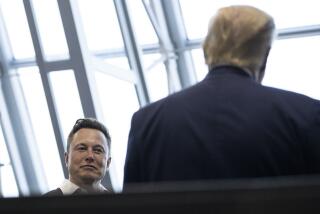Cisco Directors’ Ties to Venture Firm Raise Questions
Second of two parts.
As one of Silicon Valley’s best regarded and most powerful firms, networking equipment maker Cisco Systems Inc. enjoys close relationships with other pillars of the technology elite.
Those alliances help the San Jose company stay on the cutting edge of technology and ahead of the competition. But they also present what some see as conflicts, potentially pitting the interests of Cisco’s top executives and board members against those of the company and its shareholders.
In particular, Cisco’s long-standing ties to Sequoia Capital, one of the Silicon Valley’s top-drawer venture capital firms, raise questions about the allegiance of company executives and board members.
On paper, Cisco’s policy on conflicts of interest is clear. “Cisco employees and members of their immediate families must avoid any direct or indirect financial relationship that could cause divided loyalty,” the employee handbook states.
Yet in the case of Sequoia, what looks like a black-and-white prohibition is riddled with shades of gray.
Based in Menlo Park, Sequoia has funded some of Silicon Valley’s biggest stars, including Apple Computer Inc., Google Inc. and Yahoo Inc. Sequoia also provided Cisco with its initial funding in 1987. Donald Valentine, Sequoia’s founder and general partner, was once Cisco’s chief executive and now serves on its board.
Other investors in Sequoia, according to regulatory filings, include Cisco Chief Executive John Chambers; Chairman John Morgridge; and director and just-retired Chief Financial Officer Larry Carter. Cisco Senior Vice President Michelangelo Volpi and Cisco board member Carol Bartz, the CEO of Autodesk Inc., also have stakes in Sequoia funds.
Other Cisco directors have indirect ties to Sequoia. For instance, people close to the venture capital firm say that Stanford University is a Sequoia investor; John Hennessy, the university’s president, sits on Cisco’s board.
Sequoia made its name by investing in promising companies that went on to great success; it makes its money by cashing out of them.
That often happens when one of its start-ups is acquired by a larger firm. Such deals helped Sequoia’s funds report gains of as much as 1,200% for their investors, reports given to its limited partners show.
Meanwhile, as Sequoia looked to build up and then sell off companies, Cisco was hungry to buy. Far more than other technology stalwarts, Cisco depended on acquisitions as a core part of its growth strategy through 2000.
Of the more than 70 companies Cisco has acquired over the years, at least 12 were backed by Sequoia, Cisco acknowledges. Altogether, Cisco spent more than $1 billion to buy those firms in deals that put tens of millions of dollars in Sequoia’s coffers.
In the largest of these transactions, Cisco paid $500 million for Monterey Networks Inc. in 1999, sending at least $50 million to Sequoia, according to people familiar with the details. The acquisition was a disaster, and Cisco abandoned Monterey’s main product -- a high-end optical switch -- in 2001.
Cisco’s other purchases of companies backed by Sequoia include Netsys in 1996; Ardent in 1997; StratumOne, Pipelinks, Sentient Networks and MaxComm in 1999; Netiverse and Pentacom in 2000; and Allegro in 2001. (Since the downturn in the high-tech sector, Cisco’s pace of acquisitions has slowed.)
Because a Sequoia investor may be in just one of the firm’s dozen or so venture funds -- and because the roster of each fund isn’t public -- it’s difficult to tell who on Cisco’s board benefited directly from any particular Cisco acquisition.
People close to Cisco say that the firm’s conflict-of-interest policies have required only Valentine, the Sequoia executive, to recuse himself from debates over acquisitions of Sequoia-backed firms. The other directors who are Sequoia investors have voted on acquisitions involving Sequoia-funded companies, even if they benefited directly as a result, these people say.
The people familiar with Cisco’s practices say these directors were allowed to vote because they didn’t have executive control or majority ownership of the acquisition targets at issue. These people add that the directors were already so wealthy that their gains from the deals weren’t material to them.
Valentine declined to comment, and other Cisco directors couldn’t be reached or didn’t return calls.
“There has been no conflict of interest with respect to the actions of Cisco’s board of directors,” Cisco said in a statement. “Any decision Cisco ever made to acquire a company was based solely on the belief that the acquisition was beneficial to Cisco and its shareholders.”
Sometimes, Sequoia-related acquisitions had to be approved by a majority of Cisco’s 12-member board. In other cases, all that was needed was the consent of its five-member acquisition committee.
Currently, four of the five people on Cisco’s acquisition committee are Sequoia investors: Chambers, Morgridge, Valentine and Bartz. Although the makeup of the panel has changed over time, Valentine, Chambers and Morgridge have been on it every year since 1996, regulatory filings show. During that span, Sequoia investors have constituted a majority of the Cisco acquisitions committee.
Kirk Hansen, executive director of the Markkula Center for Applied Ethics at Santa Clara University, said allowing Cisco board members to vote on deals involving start-ups in which they have personal investments may entice them to put their own interests ahead of those of Cisco and its shareholders.
“You do have to be concerned about the structure of relationships,” Hansen said. Having an insight into “potential acquisition targets is useful. On the other hand, there is the general problem of conflict of interest.”
The close connection between Cisco and Sequoia is cited in a group of 17 class-action lawsuits that have been consolidated in federal court in San Jose. They contend that Cisco and its top executives paid too much for Sequoia-backed firms, and that certain executives failed to disclose the extent to which they stood to benefit personally from these transactions. Cisco says the shareholder suits are meritless and that it will “vigorously” defend itself.
It isn’t unusual in Silicon Valley for a venture capitalist to help fund a new firm and keep a seat on that firm’s board well after it sells stock to the public. Often, the venture capitalist will invite the CEO or other key executives to become investors in his venture funds.
In addition, other big Valley companies have been criticized for having too many directors with close ties to the companies they serve, their managers or each other. Some shareholders have complained that too many insiders might lead boards to place too little emphasis on what’s good for investors.
But longtime venture capitalists, executives and observers are hard pressed to name any public company with as deep a relationship to a single venture firm as Cisco has with Sequoia.
“I would hope this is very unusual, because it is not healthy,” said Duke University law professor James Cox, a corporate governance expert who has testified before Congress.
The makeup of the acquisitions committee, in particular, is “really troubling,” Cox added. “It does have implications about whether you’re acting totally in good faith for the company.”
People with knowledge of the Cisco directors’ actions point out that those who have stood to gain personally from a Sequoia-connected deal generally have voted the same as their fellow board members.
Cox, however, said that this still left a “go along, get along” problem.
“They may see that if they reject a Sequoia opportunity on behalf of Cisco,” he said, “they may not be approached” to get in on the next hot Sequoia fund.






